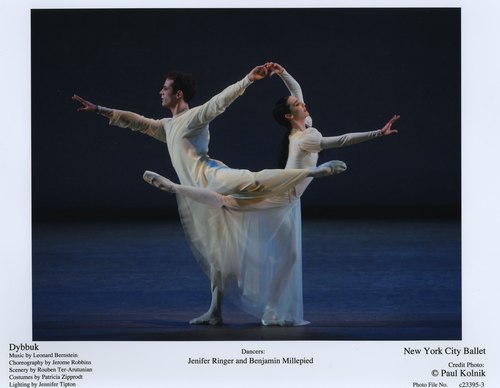|
 |
|
|
 |
 |
(Read More NYC Ballet Reviews).Conductor: Maurice KaplowSerenade Tribute to Ruthanna BorisSerenade (1948): ( See January 25, 2003 Review). Music by Peter Ilyitch Tschaikovsky, Choreography by George Balanchine, Costumes by Karinska, Original Lighting by Ronald Bates, Lighting by Mark Stanley, Performed by Ashley Bouder, Maria Kowroski, Kyra Nichols, Stephen Hanna, Philip Neal, and the Company. Set to Tschaikovsky's "Serenade for Strings, this was Balanchine's first ballet choreographed in America. (NYCB Notes) One of City Ballet's exquisite works in the repertoire, with a mostly female ensemble, in Karinska's pale blue, tulle gowns, Giselle-like in transparency, Serenade should be presented much more often. Balanchine creates symmetry, in his earliest American ballet, on a dimly lit stage, and it was a miracle to see so much of Kyra Nichols, who sadly retires (this June). Ms. Nichols was joined by the crème de la crème, Ashley Bouder and Maria Kowroski, with feet turned just so, for elegant serenity, amidst this luscious Tschaikovsky score for strings. Philip Neal and Stephen Hanna were intrinsically woven into the subtly dramatic partnering, but the female leads carried this ballet. Of the ensemble, Ana Sophia Scheller was exceptionally dazzling, in her detailed limbs and position of her head, somewhat like Chopiniana. For its many textured layers to be duly absorbed, Serenade should be seen twice in succession. Dybbuk (1974, World Premiere of Revival): Music by Leonard Bernstein, Choreography by Jerome Robbins, Scenery by Rouben Ter-Arutunian, Costumes by Patricia Zipprodt, Costumes Supervised by Holly Hynes, Lighting by Jennifer Tipton, Baritone: Christopher Schaldenbrand, Bass-Baritone: Philip Horst, Performed by Jenifer Ringer, Benjamin Millepied, Sean Suozzi, Adrian Danchig-Waring, Antonio Carmena, Jonathan Stafford, Tyler Angle, Adam Hendrickson, Robert Fairchild, Allen Peiffer, Christian Tworzyanski, Faye Arthurs, Amanda Hankes, and the Company. The "dybbuk" is a spirit that enters and stays in the body of the living. The living body speaks and acts as the dead one. S. Ansky wrote a Yiddish play, a point of departure for related dances about rituals and hallucinations.(NYCB Notes). Unlike Serenade, in this writer's opinion, Jerome Robbins' Dybbuk need not be frequently presented. It's endless, dissonant, harsh, atonal, and, to be honest, cacophonic score, by Leonard Bernstein, sent my nerves a-shatter. Men dancing in black Hassidic robes, to pounding percussion, seemed to overwhelm the sensual and intense imagery of Jenifer Ringer and Benjamin Millepied, all in white. The program notes were much too lengthy for a brief, crowded intermission, and on re-reading, they still did not quite illuminate the dance. The theme, of parental marital mandate, reminiscent of the more tuneful and user-friendly Fiddler on the Roof, involves rich vs. poor husband potential, and the mystics at the Kabbalah. Benjamin Millepied, who apparently becomes a "dybbuk", possessed and obsessed, and Leah, his betrothed, are finally free, after death, from evil spirits, or something along those lines. As a new and unfamiliar ballet to most balletomanes (This is no Giselle or Swan Lake), and wrapped in angry, percussive overtones, the imagery of black-robed men holding hands in dancing circles seemed stilted and soporific. Some of the finest male soloists and corps dancers were onstage, such as Adam Hendrickson, Tyler Angle, Adrian Danchig-Waring, and Jonathan Stafford, and their talents seemed constrained and misappropriated. The bass-baritone and baritone only added to the angst of the moment. Leonard Bernstein's musical score may be better served in orchestral concert, and Jerome Robbins' ballet may be better served in excerpted fashion. Stravinsky Violin Concerto (1972): ( See January 12, 2005 Review). Music by Igor Stravinsky ( Concerto for Violin and Orchestra in D Major), Choreography by George Balanchine, Lighting by Mark Stanley, Solo Violinist: Kurt Nikkanen, Performed by Yvonne Borree, Wendy Whelan, Nilas Martins, Albert Evans, and the Company. This music premiered in 1931, Stravinsky conducting and Samuel Dushkin as solo violinist. In 1941, Balanchine used this music for dance for the original Ballets Russes, under the title, Balustrade. (NYCB Notes).After Dybbuk, Stravinsky seemed like Sousa! I even changed my seat for more "breathing room", and Stravinsky Violin Concerto was sheer delight. Kurt Nikkanen almost stole the moment with a most virtuosic violin solo. The luminous Yvonne Borree was partnered by the charismatic Nilas Martins, and the glowing Wendy Whelan was partnered by the mesmerizing Albert Evans. The Toccata brought out all four leads with a large ensemble, swinging arms, rolling wrists, and running about. There was energy, electricity, and panache. Ms. Whelan and Mr. Evans joined for Aria I, and Ms. Borree and Mr. Martins joined for Aria II. The Capriccio brought the entire cast back onstage, and the long, "serious" "Masters at Work" program just became entertaining and engaging.
 Kyra Nichols, Stephen Hanna and Maria Kowroski in NYCB's Serenade Photo © & courtesy of Paul Kolnik |
|
 Jenifer Ringer and Benjamin Millepied in NYCB's Dybbuk Photo © & courtesy of Paul Kolnik |
|
|
|




